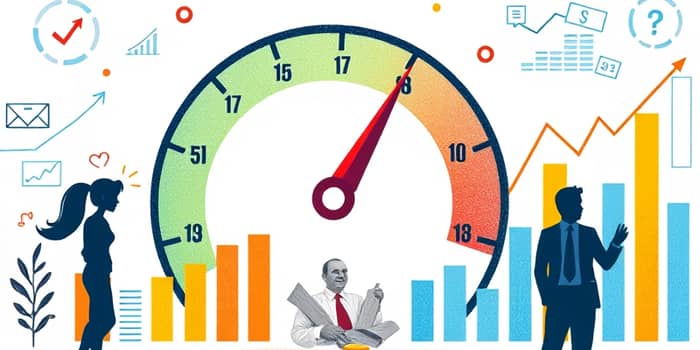
In today’s volatile financial landscape, lenders and consumers face a shared challenge: understanding how sudden increases in credit usage can influence new credit approvals. With revolving credit balances climbing due to economic pressures, credit utilization rate metric has never been more critical to monitor for both issuing institutions and applicants.
Credit utilization measures the percentage of your available revolving credit used at any moment. It is calculated by dividing total credit card balances by your total credit limits, then multiplying by 100 to produce a utilization percentage. Despite its simplicity, this metric has a substantial impact on financial profiles.
Utilization is a major component in credit scoring models. In FICO scoring, it accounts for 30% of your FICO score, second only to payment history. Both overall utilization across all your accounts and the utilization on individual cards are assessed. A single high-balance card can outweigh lower balances elsewhere, leading to score fluctuations even for disciplined consumers.
Credit bureaus gather utilization data from monthly reports by issuers. Timing is crucial: balances reported right before statement closing often appear on your credit report for that cycle. Consumers who pay balances early in the cycle may see lower reported utilization, underscoring the importance of payment timing and diligent account monitoring.
Usage spikes typically arise from large purchases, emergency expenses, or shifting payment behaviors. For example, imagine a consumer who normally keeps balances around 20% suddenly charges an appliance during home renovations, pushing utilization to 65%. Within weeks, that consumer’s score could drop by 20 to 40 points, depending on other factors in their profile.
Once issuers report new balances, traditional scoring models update within about thirty days, so score changes can be prompt. However, newer trended data models such as FICO 10 T and VantageScore 4.0 analyze up to 24 months of historical utilization. These advanced algorithms capture not just isolated spikes but the frequency and intensity of spikes, rewarding steady management and penalizing erratic behavior.
Another nuance involves the difference between a statement balance and a current balance. A cardholder might pay a large purchase off immediately, but if the payment posts after the statement closing date, the spike still records on the report. Understanding issuer reporting cycles and scheduling payments before the close date is essential to prevent unintended credit score impacts.
From a risk management standpoint, recent utilization spikes are red flags. They can indicate a borrower is stretching financial resources, possibly due to unforeseen circumstances or a pattern of overspending. A high spike might not be problematic if quickly resolved, but a cluster of spikes over several months suggests a deeper trend.
Underwriting guidelines often factor in utilization trends alongside other indicators like debt-to-income ratios and employment stability. Lenders may impose stricter terms—higher interest rates or lower credit lines—on applicants presenting recent spikes, or in some cases, deny applications outright to mitigate exposure.
By combining score data with statement-level usage analysis, lenders achieve greater insight into borrower behavior than through summary scores alone. This layered approach helps financial institutions reduce default rates, manage portfolio health, and comply with regulatory expectations regarding responsible lending.
American consumers collectively owe more on credit cards than ever before. In Q2 2024, credit card balances surged by $27 billion quarter-over-quarter—a 5.8% year-over-year increase. This uptick correlates strongly with inflation and cost of living increases that have stretched household budgets.
Economic factors such as rising interest rates and fluctuating employment markets have also driven changes in consumer payment behavior. Many cardholders who once paid in full now carry balances, driving average utilization rates higher. Segments like younger adults and those with limited credit histories are particularly vulnerable to rapid utilization swings, as they often lack established buffers of emergency savings.
Understanding industry benchmarks can help both applicants and issuers set realistic expectations. The table below summarizes utilization thresholds and their typical credit impacts:
Lenders use these benchmarks to calibrate underwriting policies. Applicants who consistently maintain low utilization are prime candidates for credit line increases and favorable loan terms, reinforcing a virtuous cycle of responsible credit usage.
Proactive measures can help mitigate the negative impact of utilization spikes, fostering stronger credit profiles and more stable lending portfolios.
For lenders, embedding utilization spike analysis into automated decisioning engines can streamline risk assessment and reduce manual underwriting workloads. Consumers benefit from regular monitoring, alerts when utilization exceeds target thresholds, and financial education on managing revolving credit effectively.
The evolving credit landscape underscores that credit utilization remains a cornerstone metric for predicting borrower reliability. As scoring models become more sophisticated, integrating trended data and real-time reporting, both consumers and lenders must adapt strategies to manage utilization proactively.
Consumers should cultivate habits like timely payments and strategic balance management to preserve strong credit profiles. Lenders, by contrast, can leverage utilization spike reviews to enhance underwriting accuracy, reduce defaults, and support responsible lending initiatives. Together, informed practices on both sides can create more resilient financial ecosystems and empower better credit outcomes.
References













